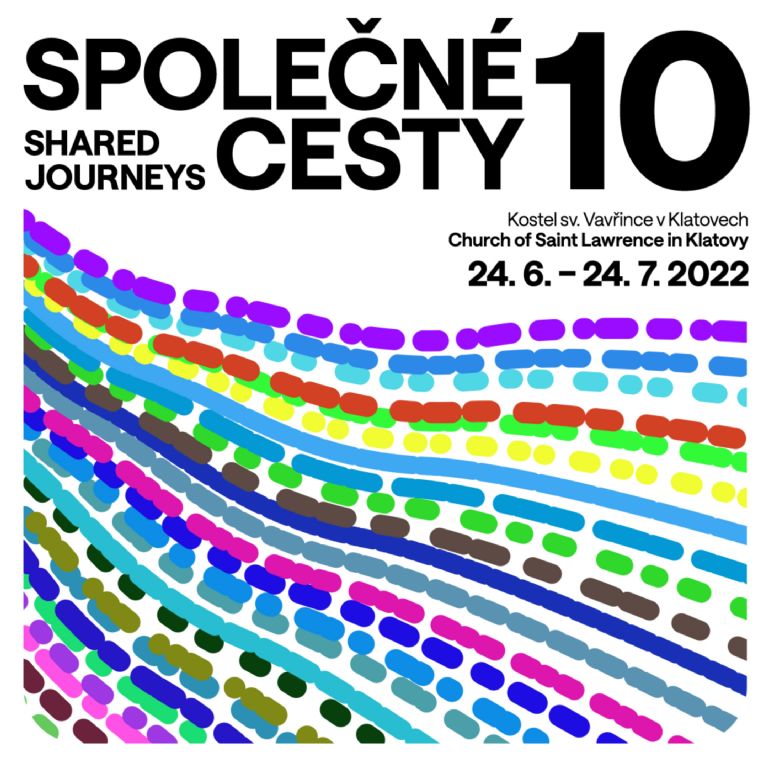Shared Journeys 10

Church of St. Lawrence in Klatovy
24. 6. - 24. 7. 2022
Curator: Petr Krátký
Architect: Matěj Kos
Graphic design: David Řeřicha
Exhibitors: Alena Anderlová, Ondřej Basjuk, Jindřich Bílek, Natalie Brehmer, Eva Červená, Miloslav Čelakovský, Gustav Fifka, Václav Fiala, Josef Frühauf, Tomáš Hrůza, Martin Kaiser, Zuzana Kantová, Tobias Lagerbauer, Jaroslav Macek, Fritz Maier, Claudia Meitert, Martin Mrkva, Rainer Neumeier, Jaroslava Papežová, Ramona Pauli, Zdeněk Pressl, Václav Sika, Jirka Skála, Zbyněk Soukup, Ladislav Sýkora, Miroslav Šisler, Petr Štěpánek, Jarmila Štěpánková, Liz Turba-Bernhardt
For the tenth time already, the paths of Czech and German artists cross at Klatovy’s Church of St. Lawrence.
The exhibition has been organized by the City of Klatovy in collaboration with the Klatovy / Klenová Gallery. This year, the works by German artists were chosen in collaboration with the Städtische Galerie Cordonhaus in Cham and the Waldmuseum in Zwiesel. The selected works by German artists are distinctly complemented by paintings, graphics, and sculptures by artists from Klatovy and the Bohemian Forest region, chosen by a team of curators from the Klatovy / Klenová Gallery.
Shared Journeys is a fitting name for this project initiated by the Klatovy artist Jindřich Bílek (1950–2014), whose main idea has been to present works made on both sides of the border between western Bohemia and Bavaria.
The first exhibition – a collaborative effort between the Klatovy / Klenová Gallery, the City of Klatovy, and its partner cities – was held in 2013 at the Baroque Church of St Lawrence in Klatovy and featured international participation by artists from Klatovy, Poligny, and Cham.
The choice of exhibited works, the location, and the compelling interior of the former Jesuit church, and the fact that the exhibition coincided with the annual Klatovy fair, meant that the exhibition possessed great audience potential and augured its future continuation.
The subsequent years, held in a similar spirit, presented mainly artists from the Klatovy-based KT-ART association and from Pilsen’s Union of Fine Artists of the Pilsen Region (UVU).
The third exhibition was held in 2015 as part of Pilsen’s year as European Capital of Culture. It was also the first time the Upper Palatinate Artists’ Association from Weiden – which has been closely collaborating with UVU since 2007 – participated in the event.
Later editions presented works by artists from the Klatovy region, whose number continued to grow each year, alongside artists from the German border region, in particular in or near the towns of Cham and Zwiesel.
The year 2020 and the events associated with the spread of the Covid-19 virus – in particular the blanket restrictions introduced by the Czech government as a preventative measure – seriously affected the form taken by our annual exhibition: For the first time in seven years, no foreign artists took part. With the ongoing pandemic, this situation was repeated the following year as well.
The exhibited works are traditionally chosen by the artists themselves, upon consultation with the curator. This selection process offers artists sufficient freedom to choose the works that will represent them at the exhibition. It is nevertheless a privilege that requires a specific strategy on the part of the curator, each of whom has taken a different approach over the years, resulting in diverse forms of exhibition installation.
The greatest challenge in this particular case is presented by the interior of the church itself, whose monumentality should act as partner for the exhibited works. The exhibition installation should take an interesting approach to working with the building’s architecture while bringing the various works of art together in a way that respects their relative proportions.
Just as last year, the works are presented through an original installation, this year designed and arranged by artist and stage designer Matěj Kos. The exhibition architecture, especially designed for this exhibition, is meant to evoke the imaginary interior of an art collector’s home in which the works have been installed. Viewers thus find themselves figuratively and literally on the boundary between two worlds – the sacred and the profane – which are literally interwoven by the exhibition.
Art should and perhaps still does have the chance to lift the human spirit and to bring us closer to higher matters and ideas. This, too, is one reason why historically the most important works of art were made in close collaboration with the church. A similar yearning almost certainly guides contemporary collectors to acquire and surround themselves with a diverse range of works of art.


 Česky
Česky
